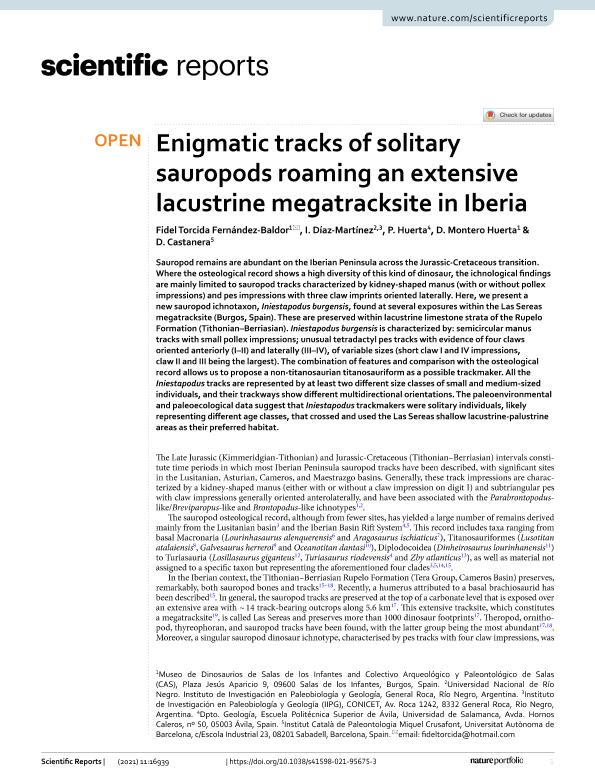Artículo
Enigmatic tracks of solitary sauropods roaming an extensive lacustrine megatracksite in Iberia
Torcida Fernández Baldor, Fidel; Díaz Martínez, Ignacio ; Huerta, P.; Montero Huerta, D.; Castanera, D.
; Huerta, P.; Montero Huerta, D.; Castanera, D.
 ; Huerta, P.; Montero Huerta, D.; Castanera, D.
; Huerta, P.; Montero Huerta, D.; Castanera, D.
Fecha de publicación:
12/2021
Editorial:
Nature
Revista:
Scientific Reports
ISSN:
2045-2322
Idioma:
Inglés
Tipo de recurso:
Artículo publicado
Clasificación temática:
Resumen
Sauropod remains are abundant on the Iberian Peninsula across the Jurassic-Cretaceous transition. Where the osteological record shows a high diversity of this kind of dinosaur, the ichnological findings are mainly limited to sauropod tracks characterized by kidney-shaped manus (with or without pollex impressions) and pes impressions with three claw imprints oriented laterally. Here, we present a new sauropod ichnotaxon, Iniestapodus burgensis, found at several exposures within the Las Sereas megatracksite (Burgos, Spain). These are preserved within lacustrine limestone strata of the Rupelo Formation (Tithonian–Berriasian). Iniestapodus burgensis is characterized by: semicircular manus tracks with small pollex impressions; unusual tetradactyl pes tracks with evidence of four claws oriented anteriorly (I–II) and laterally (III–IV), of variable sizes (short claw I and IV impressions, claw II and III being the largest). The combination of features and comparison with the osteological record allows us to propose a non-titanosaurian titanosauriform as a possible trackmaker. All the Iniestapodus tracks are represented by at least two different size classes of small and medium-sized individuals, and their trackways show different multidirectional orientations. The paleoenvironmental and paleoecological data suggest that Iniestapodus trackmakers were solitary individuals, likely representing different age classes, that crossed and used the Las Sereas shallow lacustrine-palustrine areas as their preferred habitat.
Palabras clave:
Iniestapodus
,
sauropod tracks
,
Lower Cretaceous
,
Cameros Basin
Archivos asociados
Licencia
Identificadores
Colecciones
Articulos(IIPG)
Articulos de INSTITUTO DE INVESTIGACION EN PALEOBIOLOGIA Y GEOLOGIA
Articulos de INSTITUTO DE INVESTIGACION EN PALEOBIOLOGIA Y GEOLOGIA
Citación
Torcida Fernández Baldor, Fidel; Díaz Martínez, Ignacio; Huerta, P.; Montero Huerta, D.; Castanera, D.; Enigmatic tracks of solitary sauropods roaming an extensive lacustrine megatracksite in Iberia; Nature; Scientific Reports; 11; 1; 12-2021; 1-17
Compartir
Altmétricas



